Back to top: Perception
The ancient perception
It seems that the ancient perception dependended primarily, and perhaps exclusively, on the seal, where the image
- is given in the negative, and
- it is not visible as a whole in its composition because the surface of the seal is not flat, but rolls around following the countours of the cylinder seal.
It would appear that, in antiquity, cylinder seals were not typically rolled on flat surfaces in order to show their aesthetic qualities. The few examples we have are rollings on tablets and tags, where the main function is to serve the function of authentification, and not to bring out the artistic dimension of the composition. Had this been done, we would expect that such rollings would have been baked, and one would expect in turn that at least some remnants of such artifacts would have been found in the excavations.
The main focus of attention was essentially functional, i.e., it was always related to the question of the authenticiy of whatever had been sealed.
Back to top: Perception
A clash of perceptions?
It seems hard to imagine that the ancients would have had no means of fully appreciating the aesthetic qualities of the seals the way we do. Our drawings bring out these qualities in ways that were unavailable to them, and, to repeat, there seems to have been no effort at displaying these qualities even with the limited means they had available (rolling on a flat piece of clay which would then have been fired).
A similar observation ay be made with regard to such modern drawings as those showing the section of ceramic vessels: an ancient might not even recognize the vessel as thus drawn. But these drawings do not relate to the aesthetic qualities of the object: these were inherent in the object itself, which was fully present to the ancient peerception. The rolling of a seal, on the other hand, was not visible as it us to us in our drawings.
As absurd as it may seem, it appears that we are studying something the ancients did not generally see, or at any rate did not particularly tried to see in this rendering.
Back to top: Perception
An alternate perception: the seal cutters
Why then the great effort on the part of the seal cutters? For there is no question but that the modern rendering of the rollings, and all the research that is based on them, presupposes a clear vision and a well planned procedure in translating the vision into a finished artifact.
Edith Porada (1977) pointed at “the difficulties facing the craftsman in creating a minute design in a curved surface in the negative (an intaglio) almost without the benefit of visual control” (p. 7). And she adds the following very interesting observation (based on a personal experience with a gem engraver!):”The action of the seal cutter can be described as imagining himself inside the body of the man or animal which is being represented and as carving from the inside against the outer surface” (p. 7 and note 9, emphasis mine).
Yet, the complexity of the compositions, and the subtlety with which details are rendered, would suggest that the draftsmen had some kind of physical representation of what they were going to produce, of which we may imagine two models.
- One could have been in the form of a sketch produced with a scriber’s stylus.
- Another method might have been for the seal cutters to keep a “library” of rollings on clay from previously produced seals
Back to top: Perception
An alternate perception: the clients
It seems inescapable to assume that the clients would have had an input in the process of producing a seal.
At a minimum, the client would have had a say in the choice of the theme, which could have been done without any reference to the actual composition.
Beyond that, we may think of three potential avenues for the client to indicate his or her preferences to the seal cutter.
- The most that could have happened would have been to show the client some samples from the seal cutter’s “rollings library” that would help in the selection of the composition.
- More easily, a choice of the elements that would come to be identified with the client’s personality could have been made without reference to specific visual renderings.
- When a legend was included, it was obviously the client who had to furnish the details.
Back to top: Perception
The case of Tupkish and his court
By way of example we may think of what the seals of Tupkish, Uqnitum and their courtiers suggest.
Back to top: Perception
Composition
The compositions are so personalized as to suggest a direct contribution to the very design of the seals on the part of the individuals involved (or possibly of Uqnitum also for the king’s seals).
|
The crown prince (presumably Uqnitum's son) touching the knee of his father in both a seal of Tupkish (TGL.kt2) and a seal of Uqnitum (TGL.qu2). This seems to refer to Uqnitum's claim that it is her son who will suceed his father as king. In Uqnitum's seal, her daughter is also shown as having a privileged position by sitting on her mother'lap.
|
|
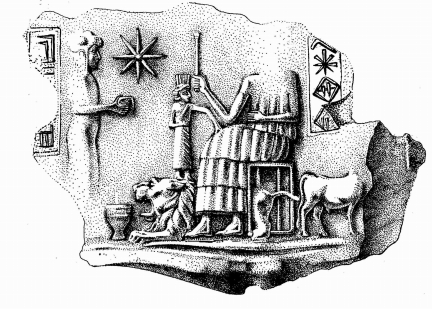
|
|
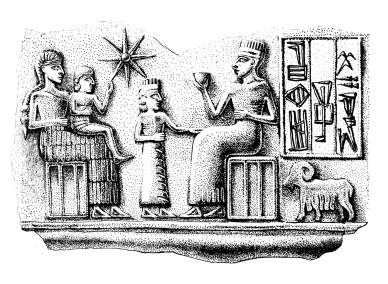
|
In several seals of Uqnitum, it is the daughter who touches the knee of her mother – which suggests a similar privilege for her eldest son (TGL.qu3, .qu4, .qu5).
[add combined drawing for qu3]
|
|
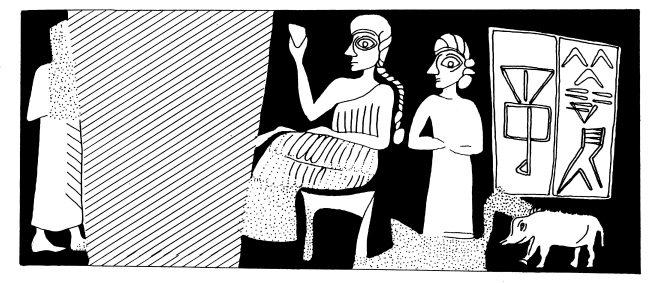
|
|
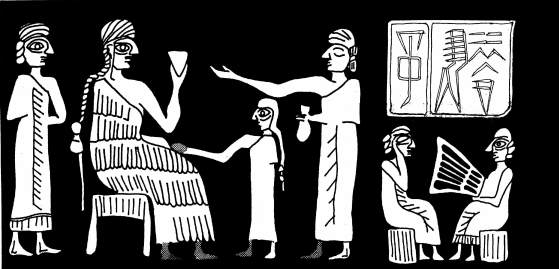
|
|
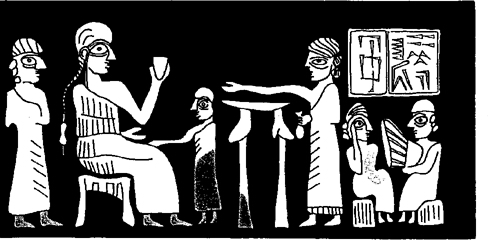
|
| Zamena and Tuii
|
Back to top: Perception
Elements
bull, boar, sheep, conceert
Back to top: Perception
Legend
even the inscription e.g. the DAM seal may suggest that Uwnitum was aware of the symbolic value of the single DAM sign
Back to top: Perception
The catalogs
black background standard for full compositions
relef occasional
contours for the rest
Back to top: Perception